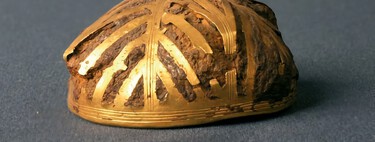In 1977, while working on a farm about three kilometres from Alcubillas (Ciudad Real), Basilio Fernández and Vicente Álvarez found a huge piece of carved red sandstone. They didn’t know it (they had no way of knowing), but they had just stumbled upon one of the most important Iberian necropolises in the region.
What we did not suspect is that inside There were jewels from the XXVI Dynasty of Ancient Egypt.
Specifically, a scarab. Scarabs are Egyptian amulets shaped like dung beetles that represented the rising Sun and symbolised resurrection. They are well known in Egyptology, but it is not common to find pieces of this type (and from this period) outside Egypt. In fact, only 15 similar pieces with these characteristics have been documented.
Quickly, the researchers They began to study the piece and found that hieroglyphic inscriptions dated it to the 26th Dynasty (between the second half of the 7th century and the middle of the 6th century BC), while “various details of the inscription” suggested that it was an object produced in Egyptian workshops.
In place of the spot… Between the 6th and 5th centuries BC, in the Jabalón Valley an important group of towns was organized (‘oppida’) Iberians. In the centre of this region, inside an urn containing the remains of a woman, an Egyptian scarab was found. According to researchers, the jewel was deposited in the middle or end of the 6th century BC.
What’s a piece like you doing in a place like this? That is the big question: how did such an exclusive piece end up in an Iberian necropolis in the interior of Spain in such a short time? Benítez de Lugo, co-director of the studio with José Luis Fuentes, explained to elDiarioclm.es which (without detracting from its uniqueness) seems somewhat rarer than it really is. “It is not so strange considering the commercial movement of the time,” he said.
In fact, in other areas of Ciudad Real (and even in the same necropolis of Alcubillas) abundant remains have been found Attic Greek ceramics. Phoenician-Punic goldwork and clear architectural influences have also been found in the area. Those centuries marked the first moments of Greek and Phoenician ‘colonization’ of the Peninsula and trade was very active.
A place (like many others) in “danger of extinction”. Because, despite the importance of the place, no administration had taken action on the matter and agricultural activity has continued for almost 45 years. It was Benítez de Lugo himself who had to “rent” the land from its owner “out of his own pocket” in order to be able to investigate it. “Pieces of Phoenician glass continued to appear, but no one had protected it,” explained.
And thank goodness.
There are many things that are not known. The same Benitez from Lugo recognized There are key details that are completely unknown. The most obvious example is the origin of the woman: “The question is whether she was an Egyptian woman or an Iberian woman with the economic means to buy or barter this prestigious object.”
Whatever the case, little by little and with a lot of effort, the deep history of the Iberian Peninsula is coming to light. And it is something fascinating.
Image | Jose Luis Fuentes Sanchez and Luis Benitez de Lugo Enrich
In Xataka |
















Add Comment